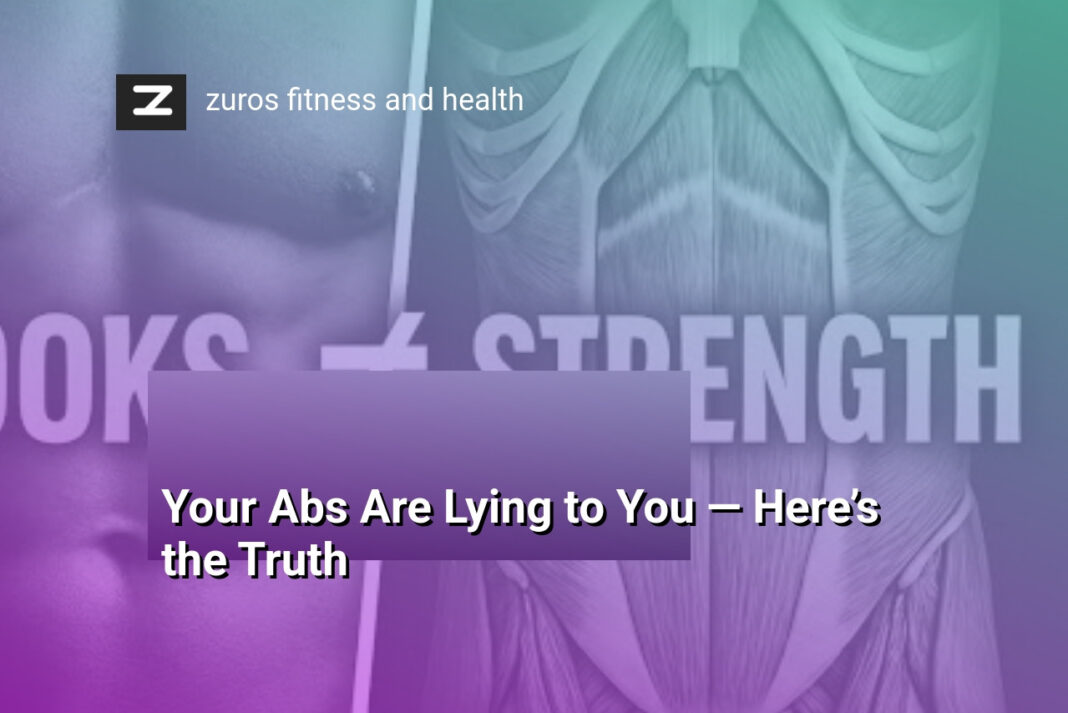The Bottom Line:
- I’ve learned that visible abs don’t necessarily indicate true physical strength, as core functionality involves much more than superficial muscle definition.
- My understanding now emphasizes that genuine core strength stems from deep muscle groups like transverse abdominis and obliques, which are crucial for spine stabilization and injury prevention.
- I recognize that traditional exercises like crunches are ineffective for developing comprehensive core strength, and instead recommend dynamic movements such as planks, bird dogs, and kettlebell carries.
- I’ve discovered that neglecting core training can lead to significant long-term health issues, including chronic pain, poor posture, and reduced athletic performance.
- My perspective has shifted from aesthetic-driven fitness to a more holistic approach that prioritizes functional strength, overall body performance, and sustainable health outcomes.
The Six-Pack Fallacy: Why Visible Abs Don’t Define Strength
The Aesthetic Illusion of Muscular Definition
Visible abdominal muscles are often misinterpreted as a definitive marker of physical prowess, but this perception fundamentally misunderstands the complex nature of core strength. Achieving a six-pack primarily depends on low body fat percentages, genetic predisposition, and strict dietary practices, rather than genuine muscular functionality. Many individuals with chiseled midsections lack the fundamental core stability required for complex athletic movements or injury prevention.
Deeper Muscular Dynamics Beyond Surface Appearance
True core strength encompasses a sophisticated network of muscles working synergistically, including the transverse abdominis, internal and external obliques, multifidus, and deep stabilizing muscles. These muscle groups provide critical spinal support, maintain postural alignment, and generate comprehensive movement power. Superficial abdominal muscles represent merely a fraction of the intricate muscular system responsible for generating functional strength and preventing potential injuries.
Performance-Driven Core Development Strategies
Effective core training transcends aesthetic goals, focusing instead on developing muscular endurance, stability, and integrated movement patterns. Exercises like planks, dead bugs, bird dogs, and kettlebell carries challenge the entire core musculature more comprehensively than traditional crunches. Professional athletes and performance specialists understand that core strength is about creating a robust, resilient foundation capable of supporting dynamic movements across various physical disciplines, not simply displaying muscular definition.
Understanding True Core Muscle Functionality
The Anatomy of Core Muscle Performance
Core muscles are far more complex than the superficial abdominal muscles most people visualize. These intricate muscle groups work synergistically to provide stability, support movement, and protect the spine during dynamic and static activities. The transverse abdominis, often called the body’s natural weightlifting belt, plays a crucial role in creating intra-abdominal pressure that stabilizes the entire kinetic chain. Unlike visible muscles that create aesthetic appeal, these deep core muscles function as a sophisticated support system for every physical movement.
Biomechanical Foundations of Core Strength
Functional core strength transcends traditional understanding of muscle development. It involves intricate neuromuscular coordination between muscle groups like the obliques, glutes, diaphragm, and deep spinal stabilizers. These muscles work not in isolation, but as an integrated network that generates and transfers force efficiently. Proper core engagement means maintaining neutral spine alignment, creating tension throughout the muscular system, and supporting movement patterns across multiple planes of motion. This complex interaction allows athletes and fitness enthusiasts to generate power, maintain balance, and prevent potential injuries during physical activities.
Comprehensive Core Muscle Activation Strategies
Developing genuine core strength requires a multifaceted approach that challenges muscles through varied movement patterns. Exercises like dead bugs, bird dogs, and loaded carries engage multiple muscle groups simultaneously, promoting functional strength development. These movements demand precise neuromuscular control, forcing the core to stabilize the body while executing complex motor patterns. By focusing on quality movement execution and progressive overload, individuals can develop a robust core that supports performance across different physical domains, from athletic pursuits to everyday functional movements.
Essential Core Muscles for Spine Stability and Injury Prevention
Understanding the Muscular Anatomy of Core Stability
The core is far more complex than traditional six-pack muscles. The transverse abdominis, often called the body’s natural weightlifting belt, plays a critical role in spine stabilization. This deep muscle wraps around the midsection horizontally, providing essential internal support during dynamic movements. Unlike superficial muscles, the transverse abdominis creates intra-abdominal pressure that protects the spine and enhances overall structural integrity.
Critical Muscle Groups for Spine Protection
Oblique muscles, both internal and external, contribute significantly to rotational stability and lateral movement control. These muscles are not just aesthetic components but fundamental in preventing potential spinal injuries during twisting motions. The multifidus muscles, running along the spine’s posterior, work silently to provide micro-adjustments and segmental stabilization. These small but powerful muscles are crucial for maintaining proper alignment and reducing unnecessary stress on vertebral structures.
Integrating Deeper Muscular Systems
Beyond abdominal muscles, the gluteal muscles and diaphragm play unexpected yet pivotal roles in core functionality. Strong glutes act as a posterior chain stabilizer, directly influencing spinal alignment and load distribution. The diaphragm, typically associated with breathing, also functions as a critical core muscle, creating pressure regulation and supporting postural control. By understanding these interconnected muscular systems, individuals can develop a more comprehensive approach to core strength that goes far beyond traditional ab-focused training methodologies.
Effective Core Training Strategies for Optimal Performance
Integrated Movement Patterns for Core Development
Developing core strength requires a comprehensive approach that moves beyond isolated muscle training. Functional movements that engage multiple muscle groups simultaneously create more effective core conditioning. Exercises like Turkish get-ups, kettlebell swings, and compound lifts such as deadlifts and squats challenge the core’s stabilization capabilities while promoting overall muscular coordination. These complex movements recruit deep core muscles including the transverse abdominis, obliques, and lower back muscles, creating a more robust and resilient muscular system.
Progressive Overload and Core Stability Techniques
Strategic progression is crucial for sustainable core strength development. Implementing techniques that gradually increase difficulty helps prevent plateaus and continuous muscle adaptation. Bodyweight exercises like planks can be advanced by introducing instability through tools such as Swiss balls, suspension trainers, or unilateral loading. Incorporating dynamic movements like pallof presses, dead bugs, and bird dogs challenges the core’s ability to maintain stability under varying resistance and movement patterns. These techniques not only build strength but also improve neuromuscular control and movement efficiency.
Holistic Core Training Methodology
Effective core training transcends traditional abdominal exercises by focusing on comprehensive muscle engagement and functional performance. Integrating breath work, isometric holds, and multi-planar movements creates a more balanced approach to core conditioning. Practitioners should prioritize exercises that challenge the body’s ability to resist rotation, maintain alignment, and transfer force effectively. This methodology includes exercises like loaded carries, rotational movements, and anti-rotation techniques that develop a more resilient and adaptable core musculature. By emphasizing quality of movement over repetitive, isolated exercises, individuals can develop a stronger, more functional core that supports overall athletic performance and reduces injury risk.
Building Sustainable Fitness: Performance Over Appearance
Holistic Approach to Core Development
Performance-driven fitness transcends superficial aesthetic goals, emphasizing functional strength and comprehensive muscular integration. True core development involves understanding the intricate relationship between muscle groups, focusing on stability, movement efficiency, and injury prevention. Athletes and fitness enthusiasts must recognize that core strength extends far beyond visible abdominal muscles, encompassing deeper muscle systems that provide fundamental structural support for the entire body.
Functional Movement and Muscle Engagement
Effective core training requires a multidimensional strategy that challenges muscles through varied movement patterns. Exercises like bird dogs, dead bugs, and kettlebell carries engage multiple muscle groups simultaneously, promoting neuromuscular coordination and developing genuine strength. These movements activate stabilizing muscles such as the transverse abdominis, obliques, and deep spinal muscles, which are critical for maintaining proper body mechanics and reducing injury risks.
Long-Term Performance and Health Sustainability
Shifting focus from aesthetic outcomes to performance-driven training creates a more sustainable fitness journey. By prioritizing functional strength, individuals develop a resilient body capable of handling complex physical demands across different activities. This approach not only enhances athletic performance but also supports long-term joint health, improves posture, and creates a more balanced muscular system. Sustainable fitness is about building a body that performs optimally, adapts efficiently, and maintains structural integrity throughout various life stages, rather than pursuing temporary visual achievements that often compromise overall physical well-being.





